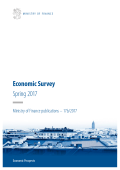Economic Survey, Spring 2017
The Finnish economy is on track to post growth of 1.2% in 2017. This growth is more broad-based than last year: not only private consumption and investment growth, but also exports growth is picking up. Growth prospects in the global economy and world trade are looking up, despite being overshadowed by the threat of protectionism. World trade is set to grow by 3% this year and to slightly accelerate towards the end of the forecast period. The Finnish economy is bolstered by accelerating growth in the euro area and rebounding export demand in response to the weakening euro.
It is projected that total output growth will come in at one per cent in 2018, climbing further to just over the one per cent mark in 2019. In 2018–2019 the main focus of growth will shift from private consumption to foreign trade. In 2017 private investment growth will be driven by business expansion and replacement investments as well as by household and investor housing purchase intentions.
Inflation will accelerate to 1.2% in 2017 on the back of rising crude oil prices, and continue to edge up slightly in 2018. It is thought that the Competitiveness Pact will contribute to reduce negotiated wages to some extent, but other factors are expected to drive nominal earnings to growth of 0.5% in 2017. The Competitiveness Pact and measures introduced from the beginning of 2017 to increase the supply of labour will bolster employment growth. Employment has developed favourably in recent years despite the sluggish economy. Measures adopted under the Competitiveness Pact will be one contributing factor. In the light of the current forecast the Government’s employment target will not be reached. High long-term and structural unemployment will present a challenge for the economy.
Debt to GDP has grown without interruption for a long time, and the debt ratio will continue to rise. In 2016 Finland’s public deficit dropped below the 3% of GDP limit, but the debt to GDP ratio will remain well above the 60% mark. The tax rate will fall in the next years ahead. The Competitiveness Pact will significantly reduce the tax rate. The expenditure rate will also fall over the outlook horizon. It is expected that the health, social services and regional government reform will initially have a slightly negative effect on public finances.
- Taloudellinen katsaus, kevät 2017
(28.04.2017)

Economic Survey, Spring 2017
28.04.2017- Julkaisut
- Valtiovarainministeriö
- Ministry of Finance publications 17b/2017
Talousnäkymät



